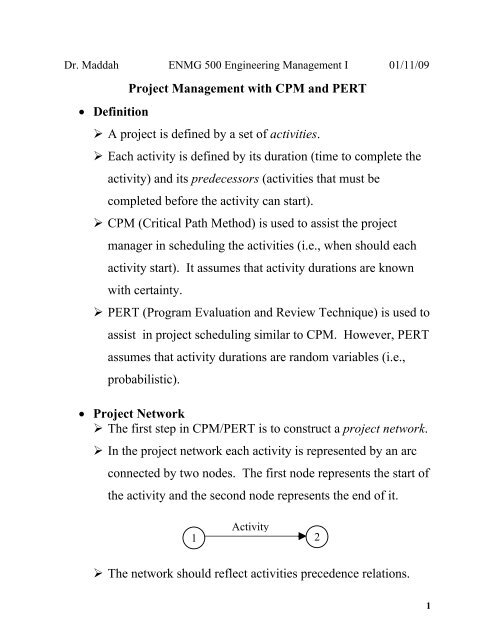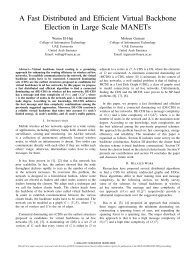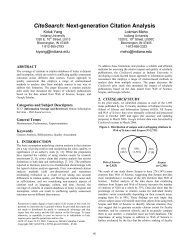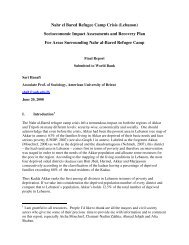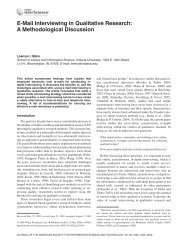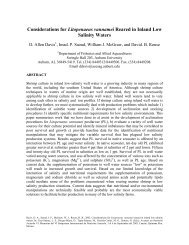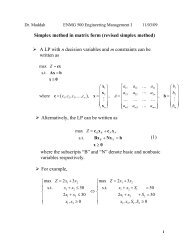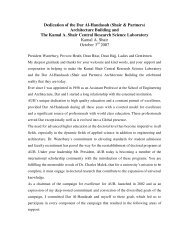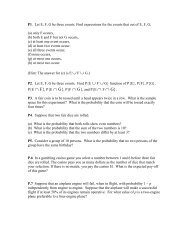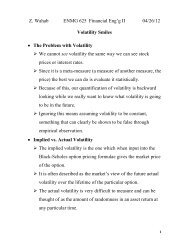Project Management with CPM and PERT ⢠Definition A project is ...
Project Management with CPM and PERT ⢠Definition A project is ...
Project Management with CPM and PERT ⢠Definition A project is ...
Create successful ePaper yourself
Turn your PDF publications into a flip-book with our unique Google optimized e-Paper software.
Dr. Maddah ENMG 500 Engineering <strong>Management</strong> I 01/11/09• <strong>Definition</strong><strong>Project</strong> <strong>Management</strong> <strong>with</strong> <strong>CPM</strong> <strong>and</strong> <strong>PERT</strong>‣ A <strong>project</strong> <strong>is</strong> defined by a set of activities.‣ Each activity <strong>is</strong> defined by its duration (time to complete theactivity) <strong>and</strong> its predecessors (activities that must becompleted before the activity can start).‣ <strong>CPM</strong> (Critical Path Method) <strong>is</strong> used to ass<strong>is</strong>t the <strong>project</strong>manager in scheduling the activities (i.e., when should eachactivity start). It assumes that activity durations are known<strong>with</strong> certainty.‣ <strong>PERT</strong> (Program Evaluation <strong>and</strong> Review Technique) <strong>is</strong> used toass<strong>is</strong>t in <strong>project</strong> scheduling similar to <strong>CPM</strong>. However, <strong>PERT</strong>assumes that activity durations are r<strong>and</strong>om variables (i.e.,probabil<strong>is</strong>tic).• <strong>Project</strong> Network‣ The first step in <strong>CPM</strong>/<strong>PERT</strong> <strong>is</strong> to construct a <strong>project</strong> network.‣ In the <strong>project</strong> network each activity <strong>is</strong> represented by an arcconnected by two nodes. The first node represents the start ofthe activity <strong>and</strong> the second node represents the end of it.Activity1 2‣ The network should reflect activities precedence relations.1
Unfortunately, <strong>PERT</strong>/<strong>CPM</strong> techniques were credited for the earlycompletion of the submarine-launched Polar<strong>is</strong> nuclear m<strong>is</strong>sile.2
‣ Given a l<strong>is</strong>t of activities <strong>and</strong> predecessors, the following rulesshould be followed to construct a <strong>project</strong> network:(1) Node 1 represents the start of the <strong>project</strong>. An arc shouldlead from it to represent activities <strong>with</strong> no predecessors.(2) A unique fin<strong>is</strong>h node representing the completion of the<strong>project</strong> should be included in the network.(3) Number the nodes in such a way that the node representingcompletion of an activity always has a larger number thanthe node representing beginning of the activity.(4) An activity should not be represented by more than one arc.(5) Two nodes could be connected by at most one arc.(6) Each node should have at least one entering arc <strong>and</strong> at leastone leaving arc.(7) Use the least possible number of nodes (optional).‣ To avoid violation of rules (4)-(6) a dummy activity <strong>with</strong> zeroduration (represented by a doted arc) may be introduced.3
‣ Examples of network construction‣ Example 1.A <strong>project</strong> to manufacture a product <strong>is</strong> composed of the followingactivities:ActivityPredecessorsDuration(days)A = train workers -- 6B = purchase row material -- 9C = manufacture product 1 A, B 8D = manufacture product 2 A, B 7E = test product 2 D 10F = Assemble products 1 <strong>and</strong> 2 C, E 124
<strong>Project</strong> networkB3C5F61DEA24‣ Example 2.The promoter of a rock concert must perform the following tasksbefore the concert can be held. Durations are in days.Activity Predecessors DurationA = find site -- 3B = find engineers A 2C = hire opening act A 6D = set radio <strong>and</strong> TV ads C 3E = set up tickets agents A 3F = prepare electronics B 3G = print advert<strong>is</strong>ing C 5H = set up transportation C 1I = rehearsals F, H 1.5J = last minute details I 2<strong>Project</strong> networkE1A2BC34HFG5DI7J865
• Early/late event time‣ The early event time for node (event) i, ET(i) <strong>is</strong> the earliest timeat which the event corresponding to node i can occur <strong>with</strong>outviolating precedence,ET() i = max( ETk ( ) + tki),(1)k∈Bwhere B i <strong>is</strong> the set of nodes directly preceding i <strong>and</strong> t ik <strong>is</strong> theduration of the activity <strong>with</strong> start node k <strong>and</strong> end node i.‣ Note that for the node representing beginning of the <strong>project</strong>ET(1) = 0. Then, ET(i) <strong>is</strong> determined from (1) recursively.‣ The late event time for node i, LT(i) <strong>is</strong> the latest time at whichthe event corresponding to i can occur <strong>with</strong>out delaying thecompletion of the <strong>project</strong>,iLT () i = min( LT ( k) − tik),(2)k∈Awhere A i <strong>is</strong> the set of nodes directly succeeding i.‣ Note that for fin<strong>is</strong>h node, n, representing end of the <strong>project</strong>LT(n) = ET(n). Then, LT(i) <strong>is</strong> determined from (2) recursively.‣ Note also that ET(n) represents the minimum time required forthe <strong>project</strong> completion .i6
• Early/late start/fin<strong>is</strong>h activity times‣ Based on the early <strong>and</strong> late event times of start node i <strong>and</strong>end node j, we define the following useful quantities for activity(i, j).‣ The early start time, ES(i, j), <strong>is</strong> the earliest time at which theactivity could start, ES(i, j) = ET(i).‣ The early fin<strong>is</strong>h time, EF(i, j), <strong>is</strong> the earliest time at which theactivity could be completed, EF(i, j) = ET(i) + t ij .‣ The late fin<strong>is</strong>h time, LF(i, j), <strong>is</strong> the latest time at which theactivity could be completed <strong>with</strong>out delaying the <strong>project</strong>,LF(i, j) = LT(j) .‣ The late start time, LS(i, j), <strong>is</strong> the latest time at which theactivity could be started <strong>with</strong>out delaying the <strong>project</strong>,LS(i, j) = LT(j) − t ij .Remark. Because nodes i <strong>and</strong> j can represent the start <strong>and</strong> end ofseveral activities, LT(i) <strong>and</strong> ET(j), in general, have no directphysical interpretation related to activity (i, j).• Floats‣ Floats are slack times by which an activity can be delayed.‣ The total float of an activity <strong>is</strong> the amount by which the starttime of the activity can be delayed <strong>with</strong>out delaying thecompletion of the <strong>project</strong>.7
‣ For an activity represented by an arc connecting nodes i <strong>and</strong> j,the total float <strong>is</strong>TF(i, j) = LT(j) − ET(i) − t ij . (3)‣ The free float of an activity <strong>is</strong> the amount by which the starttime of the activity can be delayed <strong>with</strong>out delaying thestart of any later activity beyond its earliest starting time.‣ For an activity represented by an arc connecting nodes i <strong>and</strong> j,the free float <strong>is</strong>FF(i, j) = ET(j) − ET(i) − t ij .‣ If FF(i, j) < TF(i, j), <strong>and</strong> activity (i, j) starts at time t, such thatFF(i, j) < t < TF(i,j), then activity (j, k) succeeding (i, j) cannotstart before ES(j) + t − FF(i, j).• Critical path‣ A critical activity <strong>is</strong> an activity that cannot be delayed <strong>with</strong>outdelaying the completion of the <strong>project</strong>.‣ That <strong>is</strong>, a delay of Δ days on a critical activity will increase thelength of the <strong>project</strong> by Δ days.‣ Critical activity should be monitored carefully to avoid delays.‣ A critical activity has a total float of zero.‣ A path from the start node to the fin<strong>is</strong>h node that cons<strong>is</strong>tsentirely of critical nodes <strong>is</strong> a critical path.‣ A critical path <strong>is</strong> the longest path from start node to fin<strong>is</strong>h node.‣ The length of the critical path <strong>is</strong> the minimum time required for8
<strong>project</strong> completion. It <strong>is</strong> equal to LT(n) = ET(n), where n <strong>is</strong> thefin<strong>is</strong>h node.‣ Example 3.Critical path for the network in Example 1.92638001A6B99309927DC816164E10265F12386Starting <strong>with</strong> ET(1) = 0, utilizing (1) the early event times, ET(i),i = 2, …, 6, are obtained as shown in the rectangles above each node.To find the late event times, LT(i), start <strong>with</strong> node 6 where LT(6) =ET(6) = 38. Then, utilizing (2), LT(i), i = 5, …, 1, are obtained asshown above the little squares on top of each node.Next, the total floats for each activity, TF(i, j), are evaluated from (3).Activity (i, j) Duration (t ij ) TF(i, j)A (1,3) 6 9 − 0 − 6 = 3B (1, 2) 9 9 − 0 − 9 = 0Dummy (2, 3) 0 9 − 9 − 0 = 0C (3, 5) 8 26 – 9 – 8 = 9D (3, 4) 7 16 – 9 – 7 = 0E (4, 5) 10 26 – 16 – 10 = 0F (5, 6) 12 36– 26 – 12 = 09
Critical activities are those <strong>with</strong> TF(i, j) = 0. Then, the critical path <strong>is</strong>B → D → E → F.As examples of activity related metrics, the early start time of activityA <strong>is</strong> 0, <strong>and</strong> its latest fin<strong>is</strong>h time <strong>is</strong> 9. So, A could start by time 0 <strong>and</strong>must fin<strong>is</strong>h by time 9. Similar, C could start by time 9 <strong>and</strong> must fin<strong>is</strong>hby time 26.One can construct the following schedule for th<strong>is</strong> <strong>project</strong>.B - 9D - 7E - 10A - 7F - 12C - 80 5 10 15 20 25 30 35 40• LP formulation for finding the critical path‣ Finding the critical path of a <strong>project</strong> network <strong>is</strong> equivalent tofinding the longest path between the start <strong>and</strong> fin<strong>is</strong>h nodes.‣ Let n be the number of nodes in the network, Ω be the set of arcs(activities) in the network, A i <strong>and</strong> B i be as defined on page 5.‣ For (i, j) ∈ Ω, let x ij = 1 if (i, j) <strong>is</strong> critical, <strong>and</strong> x ij = 0 otherw<strong>is</strong>e,<strong>and</strong> t ij be the duration of (i, j). Then x ij are the solution of10
max∑ij(, i j)∈Ωsubject to x = 1j∈An1k∈Bk∈Bxijtx∑∑∑iij1 jx − x = 0 , i = 2, …, n−1xkikn∑j∈A= 1= 0,1, ( i, j)∈Ω‣ The last constraint can be replaced by x ij ≥ 0, (i, j) ∈ Ω.‣ For Example 1, the LP giving the critical path <strong>is</strong>max Z = 6x + 9x + 0x + 7x + 8x + 10x + 12xiij12 13 23 34 35 45 56subject to x + x= 1x12 13− x= 0x + x −x − x= 012 2313 23 34 3512 13 23 34 35 45 56x34 45x , x , x , x , x , x , x ≥ 0− x = 0x + x − x = 035 45 56x56= 1• <strong>PERT</strong> (Program Evaluation <strong>and</strong> Review Technique)‣ The above <strong>CPM</strong> analys<strong>is</strong> assumes that activities durations areknown <strong>with</strong> certainty. Th<strong>is</strong> <strong>is</strong> not the case in many situations.‣ <strong>PERT</strong> analys<strong>is</strong> considers probabil<strong>is</strong>tic activity duration.Specifically, duration for activity (i, j), T ij , <strong>is</strong> assumed to followa Beta d<strong>is</strong>tribution <strong>with</strong> parameters a ij , m ij , <strong>and</strong> b ij .11
‣ In practice, a ij , m ij <strong>and</strong> b ij are estimated as the optim<strong>is</strong>tic, themost likely, <strong>and</strong> the pessim<strong>is</strong>tic duration of activity (i, j).‣ <strong>PERT</strong> assumes that T ij are independent r<strong>and</strong>om variable.‣ Then, the length of a path P i (i.e., the duration until event ioccurs) <strong>is</strong> a r<strong>and</strong>om variable <strong>with</strong> mean <strong>and</strong> variance∑ (k, j)∈P E[T kj ] <strong>and</strong> ∑ (k, j)∈P Var[T kj ] respectively.‣ The mean <strong>and</strong> variance of T ij , E[T ij ] <strong>and</strong> Var[T ij ], are given by2aij + 4 mij + bij ( bij −aij)ET [ij] , <strong>and</strong> Var[ Tij] .6 36= = (4)‣ <strong>PERT</strong> assumes that the occurrence time of an event (node)in the network <strong>is</strong> the same as the length of longest path leadingto the node based on expected durations of activities.‣ <strong>PERT</strong> assumes that there are enough activities on the longestpath so that the central limit theorem applies.‣ The central limit theorem states that the sum of a “large enough”number of independent r<strong>and</strong>om variables approaches a Normalr<strong>and</strong>om variable.‣ Therefore the probability that event i occurs by time t <strong>is</strong> equalprobability that the length of the longest path leading to i, L(P i ),<strong>is</strong> shorter than t, P{L(P i ) ≤ t}, where∑t−( k, j)∈P( k, j)∈PE[ T ]iPLP { (i) ≤ t} = P{ Tkj≤ t} = PZ { ≤},( k, j)∈Pi∑ var[ Tkj] (5)∑ikj12
where Z <strong>is</strong> the st<strong>and</strong>ard Normal r<strong>and</strong>om variable.‣ In particular, the critical path <strong>is</strong> often found based on theexpected activities duration.‣ Then, the probability d<strong>is</strong>tributions of the length of the criticalPath, L(CP), <strong>and</strong> of the occurrence times of events on thecritical path can be found from (5).• Critique of <strong>PERT</strong>‣ We have made many simplifying assumptions in<strong>PERT</strong> (Beta d<strong>is</strong>tribution, independence, central limit theorem).‣ Such assumptions may be unreal<strong>is</strong>tic.‣ However, <strong>PERT</strong> has proven to be a quite useful tool.‣ Recent research work improves on <strong>PERT</strong> by adopting lessrestrictive assumptions.‣ Example 4.<strong>PERT</strong> analys<strong>is</strong> of the <strong>project</strong> in Example 1. Suppose now that activitydurations are not known <strong>with</strong> certainty. Instead, pessim<strong>is</strong>tic, mostlikely, <strong>and</strong> optim<strong>is</strong>tic durations (in days) are as follows:Activity (i, j) a ij m ij b ij E[T ij ] Var[T ij ]A (1, 3) 2 6 10 6 1.778B (1, 2) 5 9 13 9 1.778C (3, 5) 3 8 13 8 2.778D (3, 4) 1 7 13 7 4E (4, 5) 8 10 12 10 0.444F (5, 6) 9 12 15 12 113
In the following we find the probability that the <strong>project</strong> <strong>is</strong> completed<strong>with</strong>in 35 days. Th<strong>is</strong> <strong>is</strong> equivalent to finding the probability that thelength of the critical path <strong>is</strong> less or equal to 35,PLCP { ( ) ≤ 35} = PLP { ( ) ≤ 35} .6Assuming that activity duration follows a Beta d<strong>is</strong>tribution, theexpected values <strong>and</strong> variance of durations, E[T ij ] <strong>and</strong> Var[T ij ], arefound from (4). Note that E[T ij ] <strong>is</strong> the same as the determin<strong>is</strong>ticdurations given in Example 1. So, we can use the critical path (B D E F) found in Example 3 to do <strong>PERT</strong> analys<strong>is</strong>.Then, the expected value <strong>and</strong> variance of the critical path length areE[L(CP)] = E[T 12 ] + E[dummy]+ E[T 34 ] + E[T 45 ] + E[T 56 ]= 9 + 0 + 7 + 10 + 12 = 38Var[L(CP)] = Var[T 12 ] + Var[dummy]+ Var[T 34 ] + Var[T 45 ] ++ Var[T 56 ] = 1.778 + 0 + 4 + 0.444 + 1 = 7.222. 1Then,35 − 38PLCP { ( ) ≤ 35} = PZ { ≤ } ≅ PZ { ≤− 1.12}=0.131,7.222where P{Z ≤ −1.12} <strong>is</strong> found using Table 1 (See also Figure 1.)In the following we also find the probability that activity E <strong>is</strong>completed <strong>with</strong>in 27 days. Th<strong>is</strong> <strong>is</strong> equivalent to finding theprobability that the longest path leading to node 5 <strong>is</strong> less or equal to 27days, P{L(P 5 ) ≤ 27}. Similar to the above,1 Use E[dummy] = Var[dummy] = 0.14
E[L(P 5 )] = E[T 12 ] + E[dummy]+ E[T 34 ] + E[T 45 ]= 9 + 0 + 7 + 10 = 26Var[L(P 5 )] = Var[T 12 ] + Var[dummy]+ Var[T 34 ] + Var[T 45 ] ++ Var[T 56 ] = 1.778 + 0 + 4 + 0.444 = 6.222.Then,27 − 26PLP { (5) ≤ 27} = PZ { ≤ } ≅ PZ { ≤ 0.40} = 0.655,6.222where P{Z ≤ 0.40} <strong>is</strong> found using Table 1.Figure 1 Area P{Z ≤ z} under the st<strong>and</strong>ard normal curve to the left of z15
Table 1 Area P{Z ≤ z} under the st<strong>and</strong>ard normal curve to the left of zd 0.00 0.01 0.02 0.03 0.04 0.05 0.06 0.07 0.08 0.090.0 0.5000 0.5040 0.5080 0.5120 0.5160 0.5199 0.5239 0.5279 0.5319 0.53590.1 0.5398 0.5438 0.5478 0.5517 0.5557 0.5596 0.5636 0.5675 0.5714 0.57530.2 0.5793 0.5832 0.5871 0.5910 0.5948 0.5987 0.6026 0.6064 0.6103 0.61410.3 0.6179 0.6217 0.6255 0.6293 0.6331 0.6368 0.6406 0.6443 0.6480 0.65170.4 0.6554 0.6591 0.6628 0.6664 0.6700 0.6736 0.6772 0.6808 0.6844 0.68790.5 0.6915 0.6950 0.6985 0.7019 0.7054 0.7088 0.7123 0.7157 0.7190 0.72240.6 0.7257 0.7291 0.7324 0.7357 0.7389 0.7422 0.7454 0.7486 0.7517 0.75490.7 0.7580 0.7611 0.7642 0.7673 0.7704 0.7734 0.7764 0.7794 0.7823 0.78520.8 0.7881 0.7910 0.7939 0.7967 0.7995 0.8023 0.8051 0.8078 0.8106 0.81330.9 0.8159 0.8186 0.8212 0.8238 0.8264 0.8289 0.8315 0.8340 0.8365 0.83891.0 0.8413 0.8438 0.8461 0.8485 0.8508 0.8531 0.8554 0.8577 0.8599 0.86211.1 0.8643 0.8665 0.8686 0.8708 0.8729 0.8749 0.8770 0.8790 0.8810 0.88301.2 0.8849 0.8869 0.8888 0.8907 0.8925 0.8944 0.8962 0.8980 0.8997 0.90151.3 0.9032 0.9049 0.9066 0.9082 0.9099 0.9115 0.9131 0.9147 0.9162 0.91771.4 0.9192 0.9207 0.9222 0.9236 0.9251 0.9265 0.9279 0.9292 0.9306 0.93191.5 0.9332 0.9345 0.9357 0.9370 0.9382 0.9394 0.9406 0.9418 0.9429 0.94411.6 0.9452 0.9463 0.9474 0.9484 0.9495 0.9505 0.9515 0.9525 0.9535 0.95451.7 0.9554 0.9564 0.9573 0.9582 0.9591 0.9599 0.9608 0.9616 0.9625 0.96331.8 0.9641 0.9649 0.9656 0.9664 0.9671 0.9678 0.9686 0.9693 0.9699 0.97061.9 0.9713 0.9719 0.9726 0.9732 0.9738 0.9744 0.9750 0.9756 0.9761 0.97672.0 0.9772 0.9778 0.9783 0.9788 0.9793 0.9798 0.9803 0.9808 0.9812 0.98172.1 0.9821 0.9826 0.9830 0.9834 0.9838 0.9842 0.9846 0.9850 0.9854 0.98572.2 0.9861 0.9864 0.9868 0.9871 0.9875 0.9878 0.9881 0.9884 0.9887 0.98902.3 0.9893 0.9896 0.9898 0.9901 0.9904 0.9906 0.9909 0.9911 0.9913 0.99162.4 0.9918 0.9920 0.9922 0.9925 0.9927 0.9929 0.9931 0.9932 0.9934 0.99362.5 0.9938 0.9940 0.9941 0.9943 0.9945 0.9946 0.9948 0.9949 0.9951 0.99522.6 0.9953 0.9955 0.9956 0.9957 0.9959 0.9960 0.9961 0.9962 0.9963 0.99642.7 0.9965 0.9966 0.9967 0.9968 0.9969 0.9970 0.9971 0.9972 0.9973 0.99742.8 0.9974 0.9975 0.9976 0.9977 0.9977 0.9978 0.9979 0.9979 0.9980 0.99812.9 0.9981 0.9982 0.9982 0.9983 0.9984 0.9984 0.9985 0.9985 0.9986 0.99863.0 0.9987 0.9987 0.9987 0.9988 0.9988 0.9989 0.9989 0.9989 0.9990 0.99903.1 0.9990 0.9991 0.9991 0.9991 0.9992 0.9992 0.9992 0.9992 0.9993 0.99933.2 0.9993 0.9993 0.9994 0.9994 0.9994 0.9994 0.9994 0.9995 0.9995 0.99953.3 0.9995 0.9995 0.9995 0.9996 0.9996 0.9996 0.9996 0.9996 0.9996 0.99973.4 0.9997 0.9997 0.9997 0.9997 0.9997 0.9997 0.9997 0.9997 0.9997 0.99983.5 0.9998 0.9998 0.9998 0.9998 0.9998 0.9998 0.9998 0.9998 0.9998 0.99983.6 0.9998 0.9998 0.9999 0.9999 0.9999 0.9999 0.9999 0.9999 0.9999 0.99993.7 0.9999 0.9999 0.9999 0.9999 0.9999 0.9999 0.9999 0.9999 0.9999 0.99993.8 0.9999 0.9999 0.9999 0.9999 0.9999 0.9999 0.9999 0.9999 0.9999 0.99993.9 1.0000 1.0000 1.0000 1.0000 1.0000 1.0000 1.0000 1.0000 1.0000 1.0000Examples. P{Z ≤ 0.40} = 0.6554,P{Z < −1.12} = 1−P{Z ≤ 1.12} = 1 − 0.8686 = 0.1314 ,P{Z >0} = 1−P{Z ≤ 0} = 1 − 0.5000 = 0.5000 .16


